May 30, 2017
Big As Life
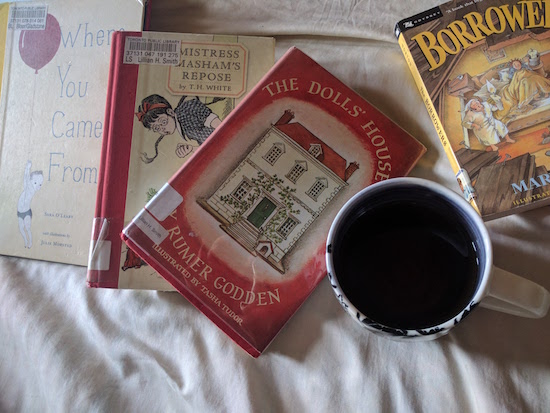
I fell in love with Sara O’Leary’s picture books back when I wasn’t even into picture books, before I had children. I discovered her via the blog Crooked House, when Stephany Aulenback published an interview with her in 2007. (Stephany Aulenback delivered me to all the best things, and I miss her blog: she is also the reason I read Harriet the Spy.) I loved O’Leary’s first picture book, When You Were Small, and it’s where my love of Julie Morstad’s work began—we’ve now got a print of hers hanging in our hallway. All of which is to say that Sara O’Leary’s work has been a part of my life in an essential way for a long time now.
And so I was particularly delighted by the opportunity to write about her books for The Walrus, an adventure that had me revisiting microscopic books at Toronto Public Library’s Osborne Collection and calling them up to clarify just how many miniature books they had—amusingly, all online references noted the collection of miniatures was “sizeable.” I got to revisit The Borrowers, and read Rumer Godden’s The Dolls’ House and T.H. White’s Mistress Mashem’s Repose. I was also recommended Jerry Griswold’s fascinating book, Feeling Like a Kid: Childhood and Children’s Literature—the chapter on “snugness” was my favourite.
So much stuff I came up with didn’t make it into the final piece (1800 words is not so long…) but it was all so fascinating. Everyone was sick in my house on Christmas Eve, which was annoying but left me free to read the entirety of O’Leary’s collection of short stories for adults, Comfort Me With Apples. (Note: she also has a novel for grown up children forthcoming next year, a ghost story which, unsurprisingly, features a dollhouse…) I was particularly struck by O’Leary’s preoccupation in these stories with so many of the ideas that would surface in her work for children a decade or more later—children with indeterminable origins, the fundamental unknowability of mothers, families that weren’t the way they were supposed to be, subtle allusions to nursery rhymes, and particularly ideas about size and scale.
I found O’Leary’s novella in the collection, “Big As Life,” made for the most fascinating companion to her Henry books. It begins with a woman sharing her first childhood memory, which her mother informs her is not a true memory but more likely something she dreamed once. This mother too who wishes to foster a more equal relationship with her daughter, to be like roommates who where the same clothes, which reminds me of the mother in When I Was Small who tells stories so she and her son “can be small together.” Lost photographs, so the woman is unable to corroborate anything she remembers from when she was small. The mother talking about her pregnancy, explaining, “Even though I was getting bigger all the time it felt like I was disappearing.”
This one extraordinary part where the women recalls the stories she used to tell her baby brother about when he was small: “I tried to tell him about who we were, what we’d been doing before he came along…I never prayed when I was a child, but somehow, telling my baby brother all I knew about life so far, I came close.”
And then this one incredible paragraph, from the perspective of a child watching her mother:
“The expression on her face—it was like she was aloft in a hot air balloon and we were all rapidly diminishing to the size and importance of ants on the ground below. It was as though soon we would grow too small to be seen, disappear, never to have existed at all. This, at least, is what I imagine, years later, trying to remember why I had grown suddenly enraged at the sight of my mother reading a book and smoking a cigarette.”
I am not sure at the connections one could make between the two works, what they mean. From reading the picture books we know that ants are actually pretty important after all and there is reverence for smallness—but perhaps you have to grow up in order to fully understand this. I think you also have to be grown-up to appreciate a mother’s desire to sometimes float away.
Parent/child relationships are complicated and fraught, it is true, but as I write in my Walrus piece, O’Leary’s picture books offer the suggestion of connection—just one of the many possibilities of small things.
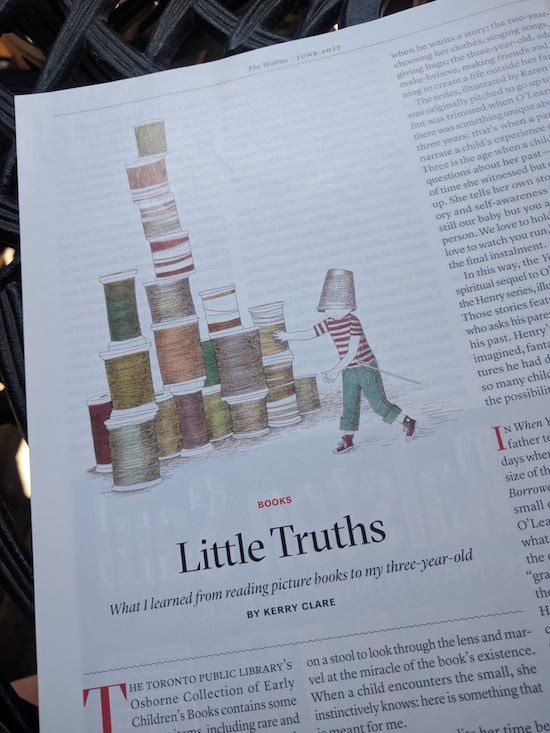
May 29, 2017
Age 8
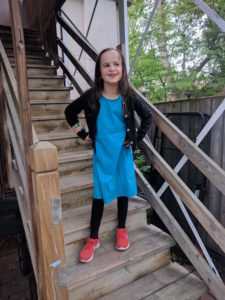 I remember being eight. I mean, I remember being younger too, but eight is the earliest age I feel a connection to: that was me then. I did a public speech on sexist stereotypes and started being praised for my story-making prowess when I was eight. I decided I wanted to be a writer when I was eight, and now I am a writer. It was a very big year. Ramona Quimby knew as much. (A joke on the back of one of Harriet’s magazines: What did the zero say to the eight? Nice belt!)
I remember being eight. I mean, I remember being younger too, but eight is the earliest age I feel a connection to: that was me then. I did a public speech on sexist stereotypes and started being praised for my story-making prowess when I was eight. I decided I wanted to be a writer when I was eight, and now I am a writer. It was a very big year. Ramona Quimby knew as much. (A joke on the back of one of Harriet’s magazines: What did the zero say to the eight? Nice belt!)
And now Harriet is eight. How extraordinary is that? That the tiny little bundle I held in my arms so long ago, that nut brown baby with that perfect little button face, a simply beautiful infant (and everyone said so) has burst forth into this girl, this small woman, all arms and legs and laugh and gappy teeth. Irrepressible. Where did she come from? Where is she going? Whoever would dare to stand in her way?
She reads, all the time now. I think it was as recently as Christmas that I’d have to promise her there were pictures in a novel before she’d consent to read it, but now she reads everything—although she’d pick up the graphic novels or Archie comics first. They’re her go-to. Her books are piled all over her house, beside my book piles, and the other book piles. She is at home here, although her domain is up on the top bunk, which is hers and hers alone.
She can’t decide whether to grow up to be a rock star or a scientist. She devours books on animal facts. I never dreamed that being a mother would mean suffering car journeys in which I am dispensed fact after fact about toad sex. She still really loves hedgehogs. She makes up weird song lyrics. Last week she made up a song about city life with the lyrics, “Luxury condos and deluxe mini-vans” and I became concerned that I was not imparting our values. She wrote an alternate verse about apartment buildings and public transit to placate me. She is very understanding.
She has secrets. She has stories. I used to write posts like this on her birthday in order to capture her exactly as she is before she becomes a whole new person tomorrow, but she is old enough now that she cannot be captured. She belongs to herself and I am simply observing, albeit with wonder. I made her, but she has nothing to do with me. She is her own incredible self going out into the world, and when she gets anxious I remind her: “You are smart and you are brave.” She will figure it all out. The process being the very point, of life itself.
She is funny, she is silly, she is grumpy, she is moody, she is sullen, she is kind. And she feels things, picking up on subtle points, throwaway details on the radio from five days ago. Sometimes I think we ought to turn the radio down, but no. This is the world and we’re giving it to her, and she deserves to know what she’s getting. This is the world, all of it, and it’s our job to figure out how to love it anyway.
She is tall, she is gangly, she has freckles across her nose. She wants to get her ears pierced, which seems reasonable, except I am afraid the first punch will scare her and she’ll be too terrified for the second, and then she’ll be an earring cyclops. She’s a bit of a melodramatic. She still loves us, so much, and we adore her too, and admire her, and enjoy her company. Most days. It’s mutual. She’s an incredible sister, and while Iris is a perfectly admirable person in her own right, we have Harriet to thank for a lot of her goodness. Iris has learned good things from her sister, kindness, patience, and how to love. Although Harriet is growing up enough that now Iris is the person walking around the house complaining because no one wants to play dragon witch hunter with her, which is the role in our household Harriet alone used to occupy. But Harriet is off somewhere reading.
She was always herself. She is becoming herself. I am so grateful that she’s in the world, and grateful to the world for bringing her to us, and I love her. I remember how it took me a little bit of time to learn to love her, which was ridiculous now, but man oh man was it ever worth the wait.
May 26, 2017
The Gold Leaf, by Kirsten Hall and Matthew Forsythe
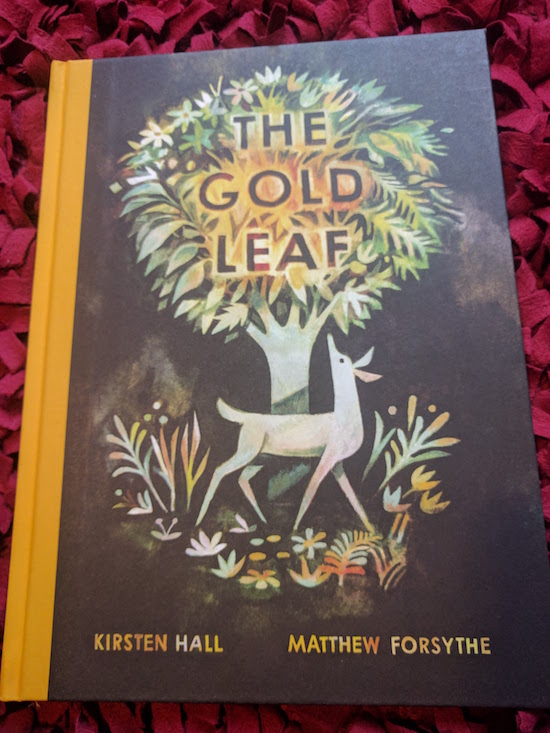
The Gold Leaf is the kind of book that you’d think at first glance was by an author/illustrator, a conceptual book in which the images are fundamental. Beautiful, lush, classical styled illustrations of a forest turning into spring.
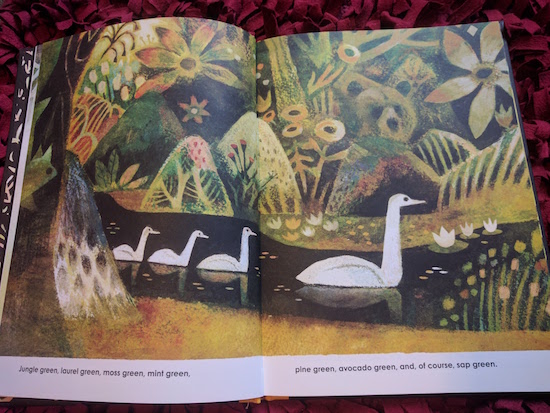
But then the words too, all the ways to describe greenness. “Jungle green, laurel green, moss green, mint green, pine green, avocado green…” I love any book that emphasizes the many different ways there are to be one thing. I also love how in this case, the splendid text is enriching the picture.
Anyway, the animals are awakening from winter slumbers and in all the newness and excitement, everyone almost misses the sight of something most unusual:
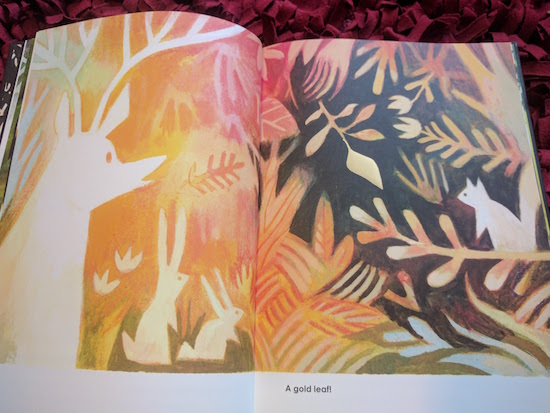

An author’s note explains the process and history of gold leaf as an art form, as well as the the author’s grandfather was responsible for the gold leafing on many famous buildings in New York City, adding another layer of texture to this beautiful story.
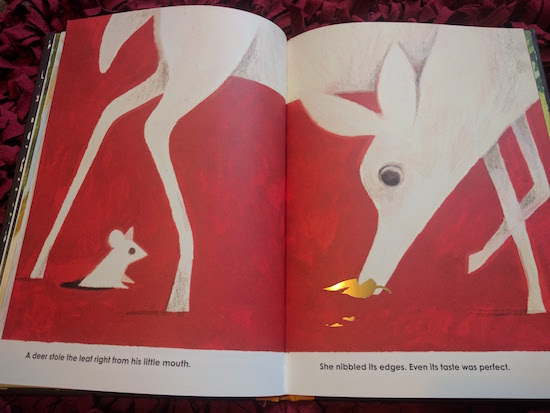
Well, obviously the gold leaf is coveted amongst the forest creatures, and one after another they snatch it, keep it, grab it and run, and the inevitable occurs—the leaf falls to pieces, scattered in the wind. And then life in the forest goes on as it should—until the following spring (with “pear green, pickle green, parakeet green…”) when the gift returns to them. A story about second chances, gifts and mercy, maybe, and community, precious resources, and how much richer we are when we take care of each other.
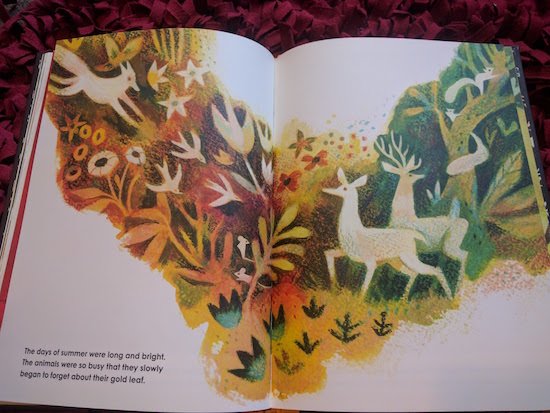
The book, in its exceptional design and quiet story, reminds me of Coralie Bickford-Smith’s The Fox and the Star, which we loved, and also a little bit of Kyo Maclean’s beautiful new book, The Fog, with its subtle environmental message and open-endedness (and also a warbler). And yet its utterly itself as well, and we absolutely love it.
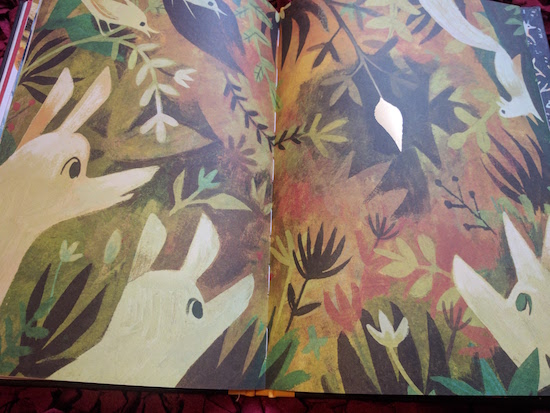
May 25, 2017
The Slip, by Mark Sampson
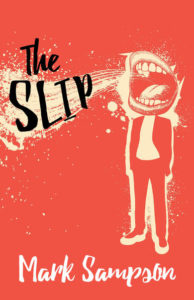 It was a very interesting moment in which to be reading Mark Sampson’s new novel, The Slip, the week after a thoughtless editorial on cultural appropriation led to an idiotic conversation on Twitter, and then the inevitable response referring to lynch-mobs and and witch hunts. In The Slip, Sampson wades into this conversation about outrage and p.c. culture, but with unfathomable thoughtfulness and nuance, and also manages to be hilarious to boot.
It was a very interesting moment in which to be reading Mark Sampson’s new novel, The Slip, the week after a thoughtless editorial on cultural appropriation led to an idiotic conversation on Twitter, and then the inevitable response referring to lynch-mobs and and witch hunts. In The Slip, Sampson wades into this conversation about outrage and p.c. culture, but with unfathomable thoughtfulness and nuance, and also manages to be hilarious to boot.
But it will take a chapter or two. I have a personal gauge for a narrative voice I’m willing to tolerate, in fiction and non, and if the word “sclerotic” is in your lexicon, you’ve basically lost me. The voice of Sampson’s narrator, absent-minded professor and public intellectual Dr. Philip Sharpe, therefore, requires some patience on the part of the reader, to be willing to entertain his allusions and extensive vocabulary. To come to understand that “entertain” is the very point: this is satire and very very funny. Don’t bother getting your dictionary out, unless you really want to increase your word power—to worry about this is to get bogged down in the details, and I’d advise you instead to lose yourself to the book’s flow.
The situation is this: left-wing intellectual Philip Sharpe says something horrifying in a televised debate with a right-wing pundit who is a woman, and I promise you you will probably gasp on page 37 just like I did. Outrage ensues, a social media furor, angry editorials, student walk-outs, etc. What caused Philip to say what he did? Well, his mind was caught up in domestic troubles, and there’s the fact that try as he might he cannot secure his poppy—the book is set in early November and to appear poppy-less on television is a national crime. And so he’s not completely in control of his faculties as his opponent tries to get the better of him. In fact, Philip is so far out of the loop that he doesn’t actually register the remark that he made that’s upset so many people. “I can be a bit oblivious,” he says at one point in the text, and I’ll say. So he cannot begin to fathom why people are so worked up about an inarticulate point he made about Canadian corporate executives in which he’d so shamefully denied the categorical imperative.
Of course, Philip Sharpe can’t fathom a lot of things—social media, for one. Or cell-phones. Or his wife’s state of mind lately, and why she refuses to get a job beyond writing a parenting column bimonthly, and what her lack of contribution means for their enormous mortgage. All of which gives Sampson a lot of space to traverse the misunderstanding between Sharpe’s supposed slip and what he’s actually said. He’s accustomed to being a bit out of sync with the world, although he’s a bit curious about why the outcry is so disproportionate. And to give us a bit of background into his situation and his character, Philip delves into his history between chapters concerned with the immediate scandal. His unconventional childhood, his time at Oxford, his first serious relationship, his years of success in academia, and his unexpected marriage in his early 40s, when he finds himself a stepfather.
The chapters about parenthood are wonderful. “When a child refuses to sleep, it can make your evening feel like it’s trapped inside a very bad prose poem—all jarring transitions and fragmented narrative arcs.” This chapter with the bad bedtime ends with Philip already at the end of his tether, looking at his daughter and asking himself a very philosophical question: “Remind me again, my love—why are you even here?” Which launches into a chapter about his daughter’s birth, a home birth through which his wife insisted on The Indigo Girls’ “Closer to Fine” playing over and over again. The chapter had me in hysterics and ended on the most excellent note, portraying the awful and ecstatic tones of parenthood.
Anyway, it all goes like this, swiftly, swiftly—I read the book in two days. Soon the anti-feminists are reaching out to support Philip, and his stepdaughter is receiving nasty notes on Facebook, and even the barkeep in Philip’s local isn’t bothering to talk to him. And then finally, the revelation. What he said isn’t what he thinks he’s said, and Philip is horrified at what he’s done, what people have been thinking. Which allows the narrative to turn into something beyond satire, into more of a critique as well on outrage culture, and outrage-at-outrage culture. In a way, The Slip is an inverted version of Zoe Whittall’s The Best Kind of People, with its take on rape culture, feminism and MRAs, and the two books are very interesting companions, making similar points in very different ways.
I loved The Slip. Mark Sampson is my friend, and I read his book intending to avoid full-disclosuring by not writing about it at all, but I liked it so much and have so much to say about it that I really couldn’t help it.
May 23, 2017
Mitzi Bytes in the World
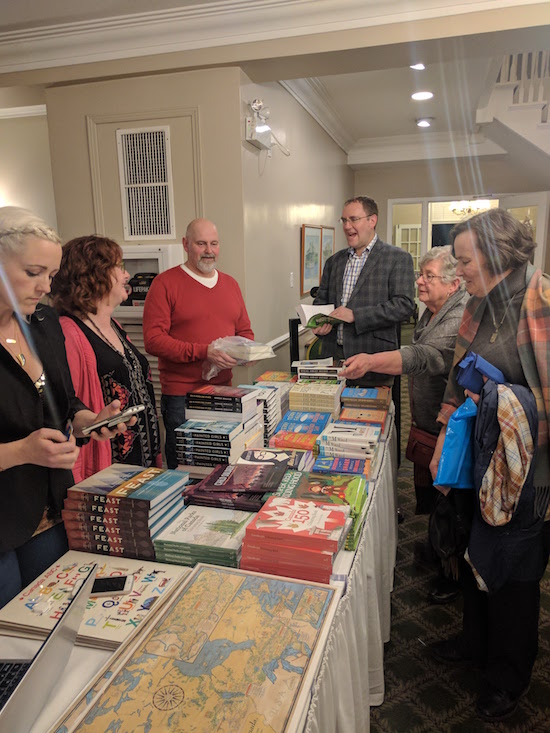
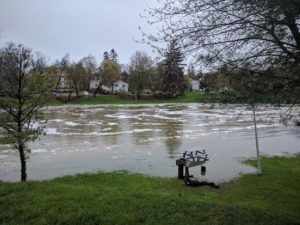 After a flurry of busy-ness, I’m playing a bit of catch-up with news of Mitzi Bytes in the world. Earlier this month I had the great pleasure of travelling to Gananoque to take part in the 1000 Islands Writers Festival. This was the weekend it rained every day following the week during which it rained every day, and by Saturday the rivers had burst their banks and there were fewer islands than a thousand. But even flooding didn’t dampen the spirit of the festival. I had a very good time, staying at the historic Gananoque Inn and rooming right next door to Lindy Mechefske, who I’ve been online friends with for awhile and whose Sir John’s Table I loved. On Saturday morning, Lindy and I did a panel about writing, blogging and social media, which was terrific fun and illuminating for all of us, and then I taught a blogging workshop following that—and got to meet Emily Prout, of the very cool and empowering blog, Arrow It Forward. My other event was later that day, a conversation about motherhood at the Gananoque Library with a small circle of women ranging from new moms to a great-grandmother—and it was wonderful. What a delight to take part in a discussion, one that really happened too, and to get to know other people and learn new things about the context of my book. I’ve never encountered such a group of engaged and committed readers as I did in Gananoque, and the intimate settings were lent themselves to that dynamic.
After a flurry of busy-ness, I’m playing a bit of catch-up with news of Mitzi Bytes in the world. Earlier this month I had the great pleasure of travelling to Gananoque to take part in the 1000 Islands Writers Festival. This was the weekend it rained every day following the week during which it rained every day, and by Saturday the rivers had burst their banks and there were fewer islands than a thousand. But even flooding didn’t dampen the spirit of the festival. I had a very good time, staying at the historic Gananoque Inn and rooming right next door to Lindy Mechefske, who I’ve been online friends with for awhile and whose Sir John’s Table I loved. On Saturday morning, Lindy and I did a panel about writing, blogging and social media, which was terrific fun and illuminating for all of us, and then I taught a blogging workshop following that—and got to meet Emily Prout, of the very cool and empowering blog, Arrow It Forward. My other event was later that day, a conversation about motherhood at the Gananoque Library with a small circle of women ranging from new moms to a great-grandmother—and it was wonderful. What a delight to take part in a discussion, one that really happened too, and to get to know other people and learn new things about the context of my book. I’ve never encountered such a group of engaged and committed readers as I did in Gananoque, and the intimate settings were lent themselves to that dynamic.
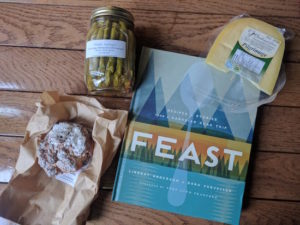 I’d gone to see novelist Terry Fallis and spoken word artist PrufRock Shadowrunner the first evening of the festival, and finished the Saturday with a wonderful and delicious event with Lindy and Lindsay Anderson and Dana VanVeller of the cookbook Feast: An Edible Roadtrip. It was also very nice to see Cathy Marie Buchanan and Claudia Davila again, and meet kids authors Paul Covello and Jess Keating (whose Pink Is For Blobflish went down very well at our house…). On Sunday morning all the authors had a delicious breakfast at the golf club on the banks of the river (which were nearer than they should have been) with a packed house of readers who’d enjoyed the weekend as much as we had. I was also glad to get a chance to check out Beggar’s Banquet Books before I headed out of town—an excellent new and used bookstore with Mitzi Bytes in stock.
I’d gone to see novelist Terry Fallis and spoken word artist PrufRock Shadowrunner the first evening of the festival, and finished the Saturday with a wonderful and delicious event with Lindy and Lindsay Anderson and Dana VanVeller of the cookbook Feast: An Edible Roadtrip. It was also very nice to see Cathy Marie Buchanan and Claudia Davila again, and meet kids authors Paul Covello and Jess Keating (whose Pink Is For Blobflish went down very well at our house…). On Sunday morning all the authors had a delicious breakfast at the golf club on the banks of the river (which were nearer than they should have been) with a packed house of readers who’d enjoyed the weekend as much as we had. I was also glad to get a chance to check out Beggar’s Banquet Books before I headed out of town—an excellent new and used bookstore with Mitzi Bytes in stock.
**
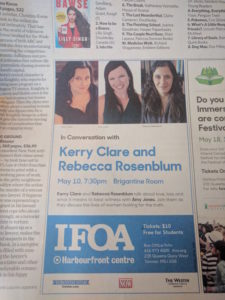 And then Wednesday night was the big finale to a very busy two months of Mitzi Bytes events—although stay tuned for other happenings throughout summer and fall. That night I had the great privilege of taking part in the IFOA Weekly Series with my very dear friend Rebecca Rosenblum, whose book So Much Love (NOMINATED FOR THE AMAZON.CA FIRST NOVEL AWARD!) came out the same day as mine. Moderated by the excellent Amy Jones and hosted by Sheniz Janmohamed, it went as well as you might expect for a conversation by two friends who have a lot of good things to say about each others’ work—which is to say, very well. Amy did a terrific job drawing connections between two novels that are very different, we all had a lot of fun, and, as Sheniz commented afterwards, we manage to broach some very timely ideas: “What does it mean to own your story? What is the responsibility that comes with telling other people’s stories?”
And then Wednesday night was the big finale to a very busy two months of Mitzi Bytes events—although stay tuned for other happenings throughout summer and fall. That night I had the great privilege of taking part in the IFOA Weekly Series with my very dear friend Rebecca Rosenblum, whose book So Much Love (NOMINATED FOR THE AMAZON.CA FIRST NOVEL AWARD!) came out the same day as mine. Moderated by the excellent Amy Jones and hosted by Sheniz Janmohamed, it went as well as you might expect for a conversation by two friends who have a lot of good things to say about each others’ work—which is to say, very well. Amy did a terrific job drawing connections between two novels that are very different, we all had a lot of fun, and, as Sheniz commented afterwards, we manage to broach some very timely ideas: “What does it mean to own your story? What is the responsibility that comes with telling other people’s stories?”
There were lots of people there, and it was such a good vibe—a spectacular close to the season of Mitzi. And I am so grateful to everybody who has supported the book so well this spring—it has meant the world to me.
**
I was also lucky to take part in two great conversations that have found their way into print. Check out “A Spy Among Us”, by Stacey Gibson at U of T Magazine, and Ann Cinzar’s interview with me at Literary Mama.
May 22, 2017
Glass Beads, by Dawn Dumont
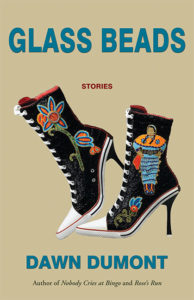 “Why is Friends on every channel?” is a question posed at the beginning of one of the inter-connected short stories in Dawn Dumont’s new book, Glass Beads, and the answer to that question is the same as the answer to another one: What makes Glass Beads so compulsively readable? A cast of compelling characters each so different and singular that their interactions create interesting conflict, plus sparkly witty dialogue. In the same way that Friends is a show you can have playing in the background, I read Glass Beads in two days. And yet—to say the book is similarly easy (the kind of thing you can have playing in the background) is to undermine its substance, the darkness at its margins and core. But still: the darkness is not the whole point.
“Why is Friends on every channel?” is a question posed at the beginning of one of the inter-connected short stories in Dawn Dumont’s new book, Glass Beads, and the answer to that question is the same as the answer to another one: What makes Glass Beads so compulsively readable? A cast of compelling characters each so different and singular that their interactions create interesting conflict, plus sparkly witty dialogue. In the same way that Friends is a show you can have playing in the background, I read Glass Beads in two days. And yet—to say the book is similarly easy (the kind of thing you can have playing in the background) is to undermine its substance, the darkness at its margins and core. But still: the darkness is not the whole point.
Last week on twitter, Tracey Lindberg asked a kind of rhetorical question about the possibility of Indigenous beach reads. A rhetorical question because her point is that Indigenous literature is pushed to be issues-based and doesn’t get to be fun, light and joyful in the way that other literatures do. And the closest answer I have to the idea of an Indigenous beach read is Dawn Dumont’s work, including Glass Beads, which follows Rose’s Run (a book I loved) and Nobody Cries at Bingo. Her work is as smart and funny as you’d expect from a writer whose background includes law and standup comedy, never shying away from big issues and politics (in Rose’s Run, a demon draws on the strength of women to seek justice for innumerable wrongs committed against them by men; in the context of missing and murdered Indigenous women, this is no small statement) but written with a decidedly commercial bent.
Billed as a collection of connected short stories, Glass Beads actually works astoundingly well as a novel, told from four perspectives between 1993 and 2008. Friends Nellie and Julie whose ties go back to childhood on their reserve, although they’re very different. Nellie is stubborn, smart and determined to become a lawyer, whereas Julie is unsettled, rattled by early loss and childhood traumas and given a lot of latitude because of her beauty. Nellie is in love with Everett, who is gorgeous but a bit dumb, and unwilling to give her the commitment she longs for. Abandoned by his parents, Everett carries his own baggage. Rounding out their foursome is Taz, who knows Nellie through the Native Students Council at their university and Everett because Taz buys drugs from his roommate. Taz and Julie become an unlikely couple, on-again and off-again as Everett and Nellie are.
The ties between the four of them deeply wound, binding, ever changing, time and experience bringing them together and apart. Nellie achieves her career goals, but find that there is still much to yearn for. Julie drifts, loses her way, and comes home again, at one point become incarcerated for her part in a fight, and is forced to partake in a substance abuse program even through she doesn’t have a substance abuse problem—but the carpentry program was full and that’s what happens when you’re a human being instead of a statistic. Taz moves from work with the provincial government to become Grand Chief of the Provincial Council of First Nations, with Nellie supporting him professionally. And Everett finally begins to the connect with the culture that was stolen from him when he lost his father, his ties to Nellie cemented when she gets pregnant with their child.
That we can read a book from four different perspectives and still not know everything, and that Dumont can create tension and shocking moments with that space beyond the limits of what we know about these characters is a testament to Glass Beads‘ craftsmanship, and why I consider it a novel more than stories—the book as a whole is deftly plotted. Its characters change and grow, harden yet remain vulnerable, get together and fall apart, and pick up the pieces again, and here we are witnessing all of it. We feel like we know them. Like a certain 1990s’ sitcom, but infinitely more interesting.
May 19, 2017
The Way Home in the Night, by Akiko Miyakoshi
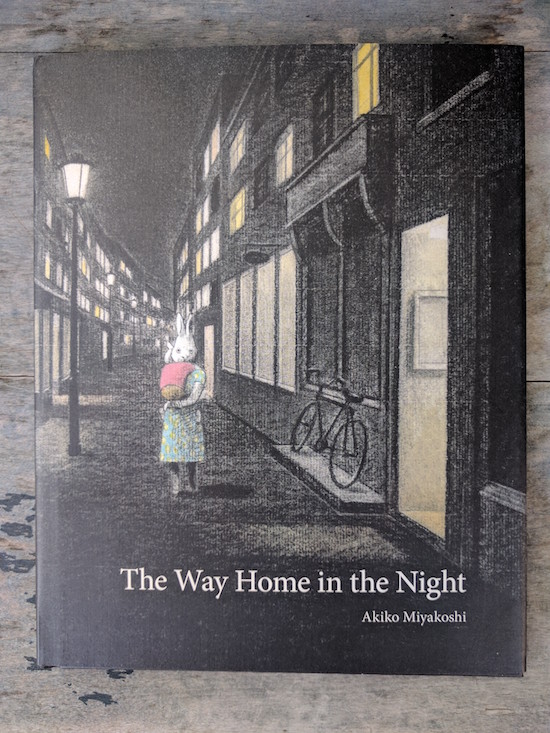
Lately I’ve been thinking a lot about the fact that everyone has their own story, about light in the dark, and pie, baths and bookshops. (The final clause of that sentence is evergreen, but still.) The Way Home in the Night, by Akiko Miyakoshi, brings all of these ideas together in a quiet thoughtful way and manages to be a lullaby—for the whole wide world.
(Check out the endpapers:)
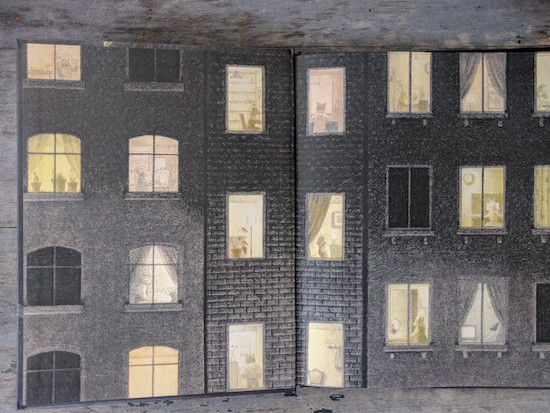
Miyakoshi’s third book in English (after The Tea Party in the Woods and The Storm), The Way Home… is about a child (rabbit?) coming home when its late, sleepy in her mother’s arms. They walk together in the darkness of the city, past stores closing up shop, through empty streets which are illuminated by streetlights and the lights from people’s windows.

The child hears vague sounds, smells different scents in the air, and ponders what these tell us about what’s going onside the lives of the people at home in all the houses.
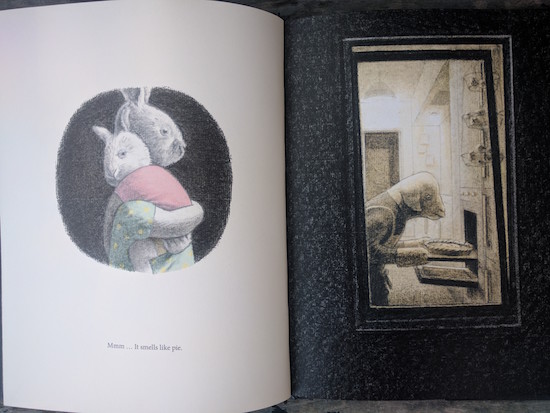
And I love that—curiosity about the lives of others, an acknowledgement that everybody is a character in their own story, stories we only sometimes get a glimpse of. That each of us is not the only person in the world, even, and that when we sleep—settling down to the bed as the narrator does after her mother tucks her in—the world is still going on without us, people going places, other people coming home.
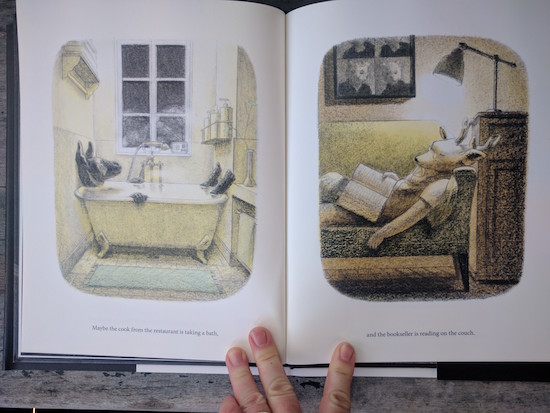
The book then turns into an exercise in storytelling as the rabbit drifts into sleep, imagining the characters she encountered on her journey making their own way home, drawing a bath, settling down with a book. What can we know about other people, the book is asking us. And what does it mean when we bother to try? The point being that this wondering is what connects all, each of us with our own lit windows, our self-contained universes. In fact, we’re all a constellation.
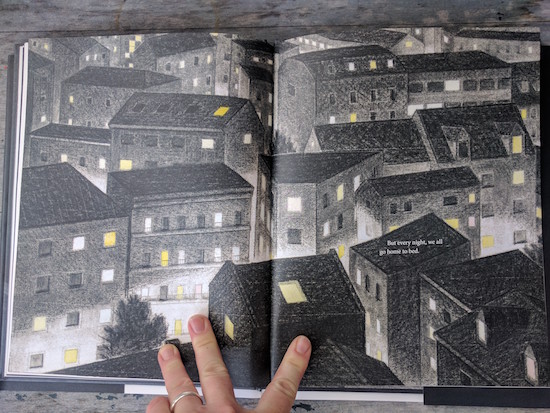
May 17, 2017
Dr. Edith Crane and the Hares of Crawley Hall, by Suzette Mayr
 Imagine Lucky Jim on acid, is how I’d pitch Suzette Mayr’s new novel, Dr. Edith Vane and the Hares of Crawley Hall, to you, a book whose momentum is swift but in the trajectory of a downward spiral, circling the drain. Just like the cover, actually, hypnotic spiral. Of jackrabbits, instead of the unicorns which had been the overriding motif in Mayr’s Monoceros, which I loved in 2011. Rabbits not like copulating like, but instead the hallucinatory sort—Harvey and Alice in Wonderland, maybe even a bit Donnie Darko. (Please check out Mayr’s answers to CBC Books’ Magic 8 questionnaire to discover the surprising way in which Downton Abbey also infiltrated the novel.)
Imagine Lucky Jim on acid, is how I’d pitch Suzette Mayr’s new novel, Dr. Edith Vane and the Hares of Crawley Hall, to you, a book whose momentum is swift but in the trajectory of a downward spiral, circling the drain. Just like the cover, actually, hypnotic spiral. Of jackrabbits, instead of the unicorns which had been the overriding motif in Mayr’s Monoceros, which I loved in 2011. Rabbits not like copulating like, but instead the hallucinatory sort—Harvey and Alice in Wonderland, maybe even a bit Donnie Darko. (Please check out Mayr’s answers to CBC Books’ Magic 8 questionnaire to discover the surprising way in which Downton Abbey also infiltrated the novel.)
It’s a campus novel and, new start, new year, Dr. Edith Vane starts out with the best intentions. Her PhD. thesis on African-Canadian pioneer Beulah Crump-Withers is finally about to be published, she has tenure, and a brand new wardrobe, including the long cardigans and a pair of expensive shoes with hourglass heels. To contend with other challenges, she has her therapist on the line who assures Edith that she is indeed the architect of her own life. Never mind the the challenges start piling on—Edith’s evil thesis supervisor reappears in her life as the department’s honorary chair, Edith’s new girlfriend is proving noncommittal and all Edith wants to do is get married; the only graduate student she’s supervising quits her mentorship, plus the Crawley Hall, the brutalist building that is home to them all, is crumbling around her, elevators jamming, maggots dropping from the ceiling, sinkholes devouring the parking lot, and jackrabbits holed up in classrooms, their droppings scattered down the hall. Or maybe that part is just in Edith’s mind. It doesn’t help that she keeps downing bottles of wine.
The momentum of this novel, which I read in two delightful days, comes from the pile-on of absurd tragedies—how could things get any worse? Suzette Mayr taking care to immediately answer the question. And yet it’s so funny, and the energy, and the satire of campus bureaucracy is so spot-on and delicious that I would never ever call this book that goes down-down-down anything like a downer. I loved it.
May 15, 2017
Good Weekend
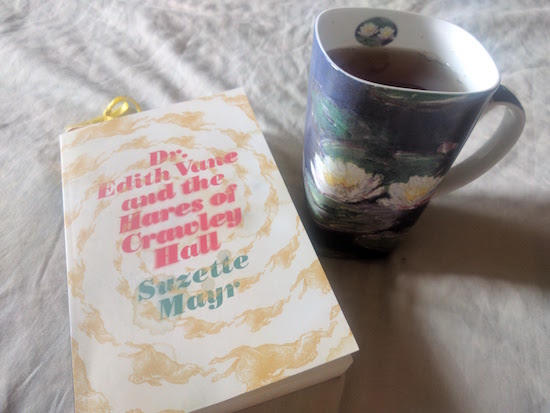
We had the most terrific weekend. Not for any particularly exhilarating reason, but instead for quite the opposite. It’s been weeks and weeks since we had a weekend with no plans in it, and during the last few weekends I’ve mostly been spending a day or more out of tow, plus. I was out a whole bunch of nights last week. And so the weekend of Mother’s Day arrived, and there was nothing else I wanted except to spend time with my children—what a thing. To turn off the internet too because there’s only so much of that shit-show one can contend with, so I spent Saturday in airplane mode, reading Suzette Mayr’s follow-up to Monoceros, Dr. Edith Vane and the Hares of Crawley Hall. Which was so good and I stayed up until midnight last night to get to the end, and after such a busy month where I’ve had so little time to read to read an entire novel in two days just felt extraordinary. I also got to partake in such things as a nap, breakfast in bed with my new waterlilies mug, afternoon tea with jam and cream in our living room with my own mom, friends for dinner and rhubarb cake, I got to read three whole newspapers, watch a bit of Mad Men, go to the park, go out for dinner, eat ice cream on Bloor Street, and dash through a rain storm—but one that was brief enough that it was sunny by the time we all walked home.
May 14, 2017
On Mother’s Day, I am grateful for my abortion.
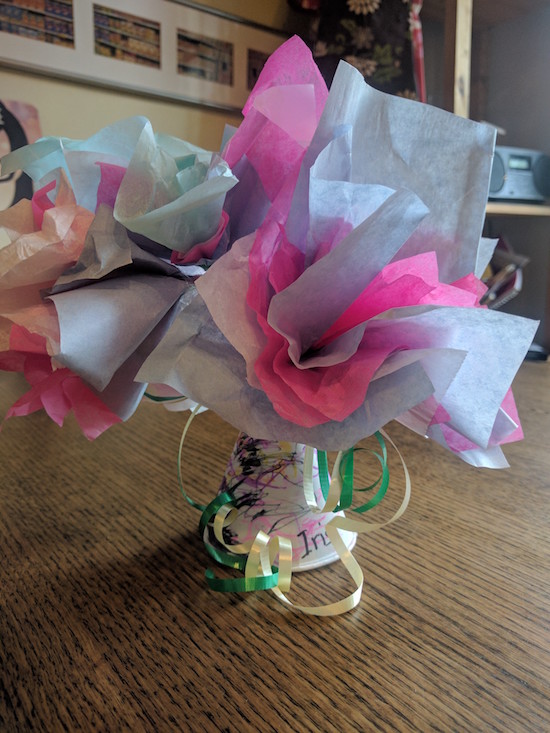
On Mother’s Day, I am grateful for my abortion. Which might sound intentionally provocative, but it isn’t. If you think very hard you might be able to fathom the banality of being grateful for this one thing upon which my adult life has hinged, from which everything since has come from, every single ordinary wonderful thing. Although I wasn’t always grateful—at the time such a thing as gratitude never occurred to me. To have the freedom to make a decision about my own body and my own destiny—that sounds kind of banal as well. It was 2002 and things were politically different, or at least I was isolated enough to think they were. At the time it wouldn’t have occurred to me that The Handmaid’s Tale was prescient.
But none of that is actually what I’m thinking about today, in 2017, amidst the conversations about cultural appropriation I’ve been listening to all for the last few days—except for yesterday when I took a blessed internet sabbatical. Instead, I am grateful for my abortion for another reason, for the ability my experiences of abortion and motherhood have given me to grasp nuance, hold uncertainty and hold two ideas in my head at once. “A single thing can have two realities.” My abortion enabled me to articulate this idea, to come to know the necessity of in-betweeness. It’s a point of view that many people a great deal smarter than I am have still not been able to grasp.
I was thinking about this this morning as I read Barbara Kay’s remarkable twitter timeline which must have originated in defence of her son who has been called out for supporting a “cultural appropriation prize” in defence of another editor who has (seemingly) been set-upon by the twitter mobs. I’ve never seen such an example of one misguided offensive thing spiralling into a whirlwind of absolutely abhorrent behaviour, the kind of behaviour that would embarrass a daycare room of toddlers, with apologies to toddlers. Barbara Kay daring to make a terrible thing even worse by for some reason claiming that positive experiences of Indigenous people in Canadian residential schools had been censored from the official report, which Kay hasn’t even read. (“Is there no subject matter you don’t know about that you feel qualified to opine on?” asks Maggie Wente on Twitter.)
It was all so preposterous that I did the thing that no one should ever do, which is click over to Barbara Kay’s timeline where she was retweeting some guy who’d tweeted, ‘Nothing says “I love you, mom” like a child you didn’t abort.’ And here, I thought, was exactly the problem. A person who’d think that was the reality of abortion and motherhood would be the person limited enough not to understand how one could support free speech and respecting Indigenous cultures. Not to see that Black Lives Matter means that all lives matter. The kind of person who doesn’t seem to get that you can find female genital mutilation appalling and still not be a raging racist, or even be a feminist who supports the right of other women to do what they like with their bodies—adorn it with a headscarf, even. That women who have abortions might be the same women who’ve mourned miscarriages, or who celebrate life-saving techniques that make it possible for babies born as early as 23 weeks to go on to thrive. These are also, I must point out, the same people who REFUSE to understand that most late-term abortions are performed on babies that were desperately wanted but nonviable due to fetal abnormalities. People who don’t get that a person like me who was so grateful for her abortion at six weeks can understand that for many women “choice” can be the lesser of two tragedies.
I am grateful for my abortion, because my experience as a pro-choice woman has informed so much of my understanding of power structures and oppression . It’s why I’m not sure “debate” is the answer, because I’ve had to stand on the street corner “debating” my bodily autonomy with a twenty year old Catholic boy, and I’m not sure it really got me anywhere. It’s why I know that “Yes, but…” is usually a better answer, and that sometimes we have to acknowledge that people really are the experts on their own lives and experiences. That listening is usually the best course. That we all have a lot to learn from each other. That sometimes the things that make us uncomfortable are the real things, and that grey areas exist for a reason and we have a lot of discover where they do.
If not for my abortion, I might think that questions have easy answers, that the world has easy answers, that life is uncomplicated, tidy and straightforward. I might not even understand that this can be true: if not for my abortion, I wouldn’t have my children. So on Mother’s Day, I’m more grateful than ever.





